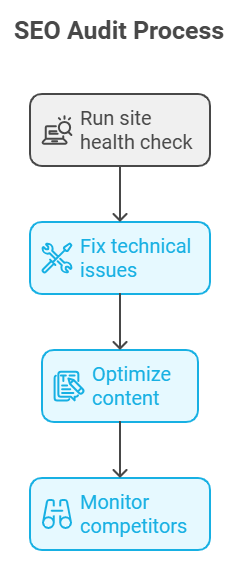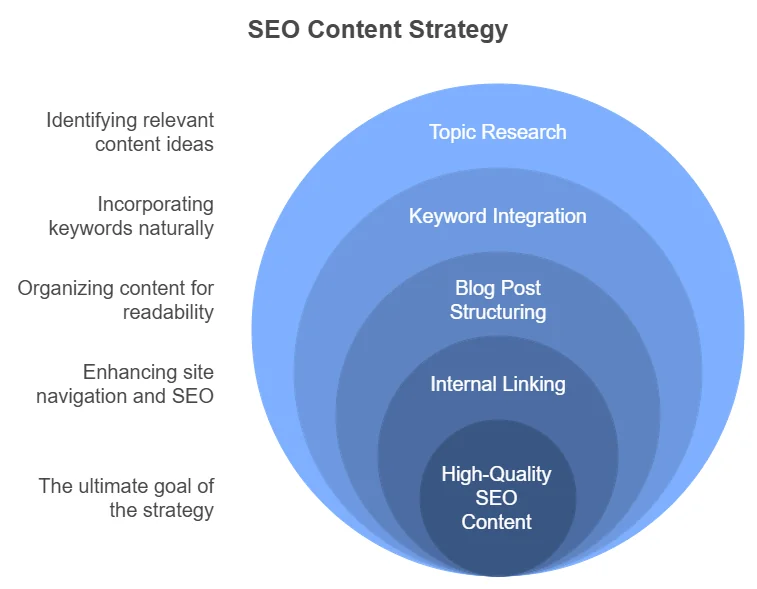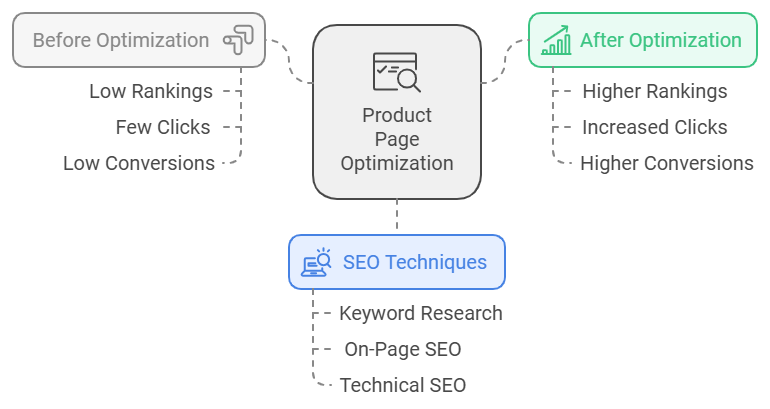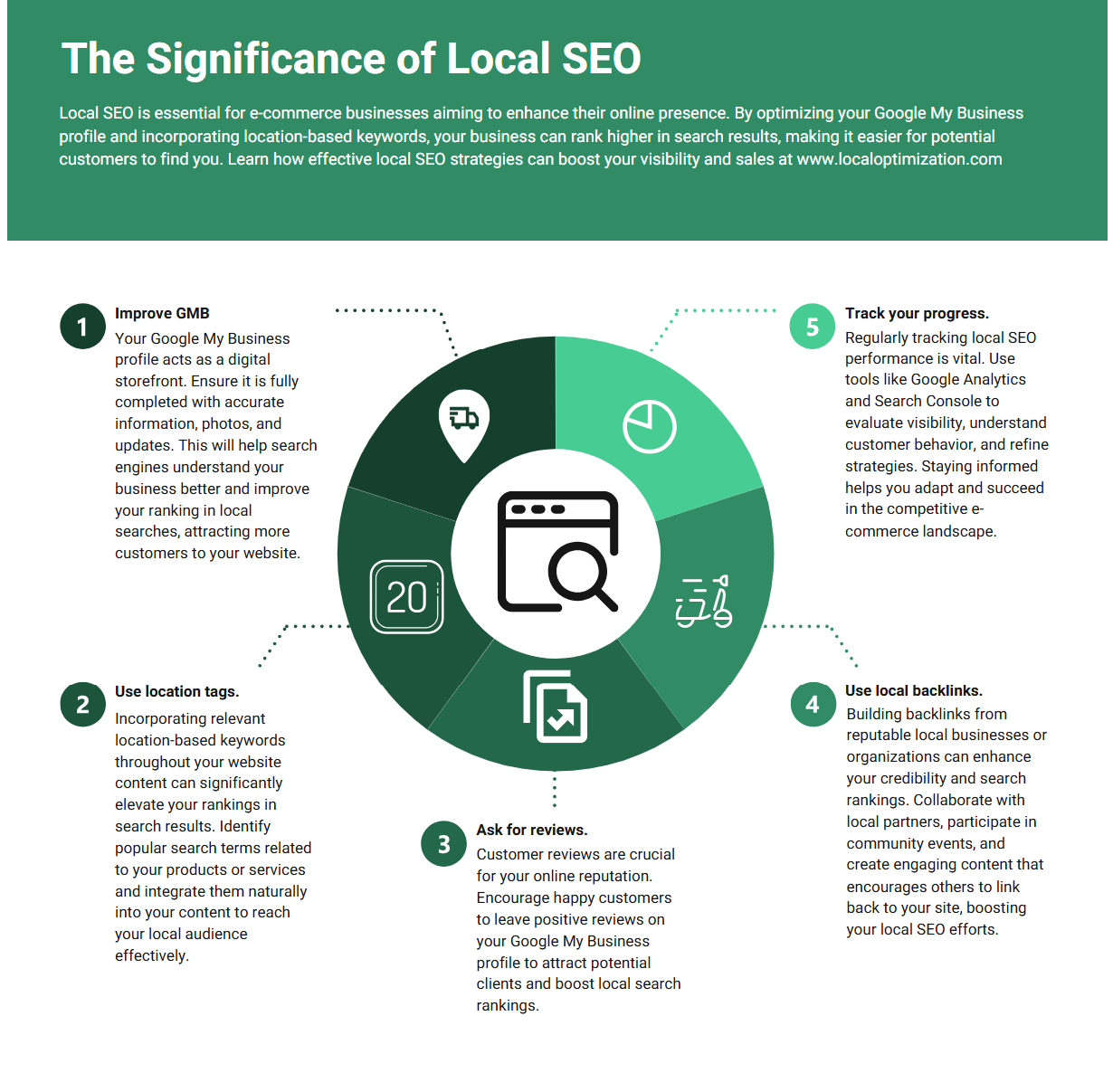PermalinkIntroduction: The Importance of SEO for E-commerce
PermalinkDid you know?
93% of online experiences start with a search engine, making SEO for e-commerce websites a critical strategy for boosting online sales and increasing organic traffic. According to ImForza, effective SEO improves visibility and drives more people to your site. In other words, if your website isn’t optimized, your e-commerce business probably isn’t going to make it.
PermalinkThe Challenge for E-commerce Businesses
The e-commerce sector is booming, but so are the competitors. Thousands of businesses compete for the same audience, and this increases the challenge to stand out. Paid ads may immediately provide visibility, but they’re cost-intensive and only temporary. The store will face challenges and may fail to attract consistent traffic and revenue if the SEO strategy is not right.
Ranking #1 on Google isn’t just about prestige; it can be a game-changer. It can bring the traffic, conversions, and sales that will help a business get ahead of its competition.
PermalinkSEO Optimization for E-commerce: The Foundation of Online Store Success
SEO is more than keywords and meta tags. It’s a holistic approach toward making your online store Rank #1 on Google. Organic SEO brings along with it:
Sustainable Growth in Traffic: Unlike paid advertisements, organic traffic grows over time.
Higher ROI: For every dollar spent, SEO delivers long-term value.
Trust and Credibility: The organic results are more trusted by the users than paid listings. SEO, therefore, forms the bedrock for trust in customers.
While many e-commerce companies spend on advertisements, those that invest in SEO set a foundation for long-term success.
PermalinkWhat This Blog Offers
This blog is a step by step guide for the top 10 e-commerce SEO strategies that have been proven to rank your site higher on Google, drive organic traffic to increase sales. These strategies are tailored for:
E-commerce store owners who want to expand their reach.
Digital marketing experts looking for actionable insights.
SEO specialists aiming to enhance their skillset.
By the end of it you’ll have a strong action plan for getting your website to a place where it’s optimized for leads, it’s attracting a target audience of your ideal customers, and then turns clicks into conversions.
PermalinkSEO Audit
PermalinkWhy Regular SEO Audits are Crucial
An effective SEO audit for e-commerce websites is the critical first step in developing advanced e-commerce SEO strategies that can dramatically improve your online store’s performance.
You can discover what is getting in the way at a more technical level, where optimization opportunities exist, and ensure that your website runs in sync with Google’s constantly changing algorithms. Audits not only ensure your site stays healthy but also allows you to stay ahead of competitors.
PermalinkActionable Tips for an Effective SEO Audit

Use SEO Audit Tools
Use SEMrush, Ahrefs and Google Search Console to get a good idea of how good or bad your site is with these tools.
Try to find metrics such as crawlability, indexing errors, keyword performance and back link quality.
Check for Technical Issues
Broken Links: Search for any links that redirect to 404 pages.
Duplicate Content: Prevent your product descriptions and blog from suffering penalization by making sure they are unique.
Missing Alt Text: Use the descriptive alt text to optimize all images for better accessibility and SEO.
Page Load Speed: There are tools that can help you spot and resolve speed and user experience issues that undermine rankings and user experience including Google PageSpeed Insights.
Audit Content Performance
Use Google Analytics and SEO tools to analyze your top performing pages.
Update the keywords for underperforming pages, their meta descriptions, and attention grabbing CTAs.
Monitor Competitors
Analyse your competitors to find out where you lack.
Look into their backlink profiles, keywords and maybe even content strategy (to see what you can learn and take advantage of for your own).
PermalinkWhy It Works
SEO audit takes care that your e-commerce site can function at its best. There are two things you’re doing when you are fixing technical issues and optimalizing content: you’re helping with performance and you’re keeping up with algorithm changes. It basically works proactively on maintaining or increasing the ranking of your web site in Google that eventually results in increasing more organic traffic as well as sales.
PermalinkConduct In-Depth Keyword Research
PermalinkWhy Keyword Research is the Foundation
E-commerce keyword research is the foundational element of advanced SEO strategies, enabling online stores to target high-intent search terms and boost e-commerce sales effectively. Without this, you’re doing the wrong things to the wrong terms —a wasted effort, or a lost opportunity. If you can find the right keywords, you will bring your content into focus with what your potential customers are currently searching for. It helps to improve the visibility of your products or services, drive more clicks and traffic to your website and most importantly convert those unique visitors into paying customers.
Doing effective keyword research means you wouldn’t focus on those terms that have high search volumes but not those which correspond to the search intent of your audience. Knowing why people search —whether the search is to find information about a product, to buy it, or to do a service— enables digital marketers to craft their words and content towards their desires.
PermalinkActionable Tips for In-Depth Keyword Research
PermalinkUse Tools Like Google Keyword Planner, Ahrefs, and SEMrush
As long as you are using advanced keyword research tools like Ahrefs or SEMrush – Google Keyword Planner – you can then identify the best keywords for your e-commerce site. These platforms offer:
Search Volume Data: Know which search terms are trending hot.
Keyword Difficulty: You can find keywords that have a high traffic but low competition and focus on ranking.
Long-Tail Keywords: They are very specific and marketing volume keywords, trading quality conversions for quantity, as they land you in front of more motivated buyers.
For instance, you won’t be limited to just “e-commerce SEO,” for example, you could instead go for “SEO for Shopify stores” or “top e-commerce SEO strategies for online stores.” Often, these long tail keywords have higher intent, in which case they’re more valuable for conversion.
PermalinkFocus on User Intent
Keyword research shouldn’t be conducted without understanding user intent. Keywords can be categorized into several types, and knowing which type is relevant to your audience can significantly improve your SEO efforts:
Transactional Intent: Buyers are looking to buy something. Keywords like “buy SEO tools for e-commerce” or “e-commerce SEO services” target these users.
Informational Intent: The users want to know something. For this category, keywords would be something like “how to improve e-commerce SEO” or “e-commerce SEO tips”.
Navigational Intent: Users are looking for a specific website or page, like “Shopify SEO guide.”
The more you hit the target behind the search query, the more your content will match the expectations of your audience and the more likely for conversions.
PermalinkMonitor Competitors
Another although effective way is to do a competitor analysis for their keyword strategy. This will give you insight on what the keywords your competitors are targeting and ranking on. It gives you a good idea of what they are doing right and what you can use to your advantage.
For instance, suppose that a competitor is ranking very well for a specific keyword, but is only offering simple content; you can make the most of this by creating deeper content full of user value.
PermalinkIdentify Content Gaps
Through competitor analysis you can also spot keywords or topics that competitors are overlooking that are important to your audience. These are opportunities to close the content gaps with more and better content that better answers user questions and provides more value.
PermalinkWhy It Works
The strength of keyword research is that it helps target terms which your potential customers are actively searching for. By focusing on the right keywords, you:
Help you attract more qualified traffic.
High purchase intent target to make it more conversions.
You can stay competitive, monitoring the competition and looking for new opportunities.
As a result, you’re more likely to show up on the first page of Google and generate traffic that is more likely to flip to sales. Keyword Research is the first Lego piece of all other parts for an Ecommerce business, so it is the most important part.
PermalinkSEO Content Marketing for E-commerce: Create High-Quality, Engaging Content
PermalinkWhy Content Marketing is Crucial for SEO
Content marketing for SEO helps improve the performance of your website to get more organic traffic by creating quality content. You can keep organic traffic coming to your site, keeping users engaged and retaining the right audience back to your site again and again by consistently publishing high quality content. That means search algorithms like to look for fresh, relevant and user facing content – and that means if you’re building with both user intent and SEO best practices stuff, you’re going to rank higher.
When your site’s content answers your customers’ questions, solves their pain points, and clearly showcases your products, you’ve created an authoritative resource on your website. This, in turn, comes to win trust of both users and search engines results, so it brings long term SEO success.
PermalinkActionable Tips for Creating High-Quality, Engaging Content

PermalinkStart a Blog
Blogging is a perfect way of making a new, realistic and engaging content to get your traffic organic. If you publish posts regularly on topics that are specific to topics related to your audience (product guides, how to articles etc.), not only will you answer to user queries, you will also be increasing your SEO ranking.
“Best SEO Tools for E commerce How to Choose”
“We predict 10 of the hottest e-commerce trends to be aware of in 2025”
Blogs of this type are valuable to your audience and also help your site rank long tail keywords in order to get more qualified traffic.
PermalinkUse Long-Form Content
Long-form content of course is 1,500+ words, so it’s long enough to complete a thought, compose a well thought out sentence together and make it interesting enough to read. This will help you blog for longer and therefore help you talk about a topic in depth, answer lots of user queries and cover a broader range of keywords, thereby increasing your chances of ranking for a plethora of different terms.
An in-depth guide on “How to Optimize Product Pages for SEO” or “Complete Guide to Shopify SEO” can be valuable long-form content that not only ranks but also keeps visitors on your site longer.
PermalinkInternal Linking
Internal linking is perhaps an aspect of content marketing that gets overlooked too often. It’s essentially about creating additional site structure via linking out to other pages or products appearing within your blog posts, either to drive engagement or boost SEO.
For example, if you write a blog post on “e-commerce seo best practices for websites,” you can link to other relevant pages, such as:
Product pages
Service pages (e.g., SEO for Online Stores)
Other blog posts (e.g., “The Importance of Backlinking for E-commerce Sites”)
Internal links tell Google which pages on your site are really important and how long people stay on your site – so the fewer bounces in your site, the better.
PermalinkWhy It Works
High quality content that can be updated regularly increases user engagement and keeps your visitors on your site while also making you rank in better SEO terms. Here’s why it’s effective:
Boosts Organic Traffic: Search engines show more of this sort of content that is informative and engaging, especially if it is relevant for long tail keywords and search intent.
Encourages Social Shares and Backlinks: This will help you have a higher value content that will be shared on social media and also linked to other websites, thereby increasing your SEO.
Signals Activity and Authority to Google: Google rewards sites that get fresh content, which means sites that are updated often are given a little more appreciation over sites that don’t.
PermalinkOptimize Product Pages for SEO
PermalinkImportance of Product Page Optimization
Product page SEO optimization is crucial for e-commerce websites, directly impacting search rankings and conversion rates for online stores. They’re heavily indexed by Google and optimizing them can have a serious impact on your ranking, as well as your sales. Visibility in search results, organic traffic, and a higher ratio of visitors to customers can be greatly increased by having a well optimized product page.
PermalinkActionable Tips
PermalinkKeyword-Rich Titles
Product titles should be accurate and descriptive. Primary keywords like ‘Genuine Leather Wallet for Men – RFID Blocking’ are tried to incorporate them in the article to target the specific searches. If you contain this, it increases your chance of ranking for relevant queries.
PermalinkSEO-Friendly Product Descriptions
Create unique and interesting product descriptions. Don’t use general descriptions, instead, emphasis on the most important features and benefits, adding hesitate relevant keywords in a natural way. It further helps search engines and users understand the product better.
PermalinkImage Optimization
Make sure to include high quality images and do descriptive image alt text for all. For example, for a “Custom Wooden Desk Organizer”, the alt-text might read: “Hand crafted wooden desk organizer with compartments for pens and papers” It also makes search visibility and accessibility.
PermalinkProduct Schema Markup
Show product schema markup to show extra info such as prices, reviews and availability directly in search results. By making your products visible in rich snippets, this can boost click through rates.
PermalinkWhy It Works

To increase your product pages’ shown in search results, optimize your product pages. With good keywords, description, technical search engine optimization (technical SEO), like schema markup, your product pages have a greater opportunity to rank high and get traffic. That makes it much more likely that visitors will become customers, and drive traffic as well as convert.
PermalinkFocus on Local SEO for Regional Reach
PermalinkWhy Local SEO is Important for E-commerce

Local SEO for e-commerce stores is essential for businesses targeting regional markets and improving visibility in location-based searches.When you optimize for location based searches, you can start attracting customers who are in a position to make a purchase locally. This means reaching out to customers who are either looking for products in the region, or customers who are looking for a store to shop from within their area, by implementing seo strategies for e commerce website.
PermalinkWhat are the benefits of local SEO for my eCommerce store?
Local SEO allows e-commerce stores to raise their visibility within a location. With location specific keywords and Google My Business tools, your store can show up on different local searches and attract potential customers in the right area. If you have a physical store with retail sales or if your business covers a certain region driving in and local sales, this is particularly important. This is very helpful to stand out in a very competitive marketplace.
PermalinkActionable Tips
PermalinkGoogle My Business
If you haven’t had time already, claim and optimize your Google My Business (GMB) listing. Check that your business hours, address, phone number, product details are correct. That’s where including photos and customer reviews can add even more to your listing.
PermalinkLocation-Specific Keywords
Geo targeted keywords should be included in your product descriptions, blog posts, meta tags and titles. For instance, if you’re searching up products in your neighborhood, e.g. “Best sneakers in New York” or “Affordable furniture in Chicago,” users are more likely to use this if they’re searching for products in your area.
PermalinkLocal Listings
Take a moment to make sure that your business is in the local directories and obviously, Yelp, Yellow Pages, and local chambers of commerce. The most important thing is for your Name, Address and Phone number (NAP) to be consistent on all platforms so you stay in good standing and keep raising your local rankings.
PermalinkWhy It Works
And by localizing your site, you increase your odds of making it into geo-search result listings. It chases after more targeted traffic that are indeed close enough to buy. If applicable, local SEO increases visibility, adds relevance, and increases conversion chances — meaning higher sales and foot traffic.
Subscribe to our newsletter
Read articles from directly inside your inbox. Subscribe to the newsletter, and don't miss out.
